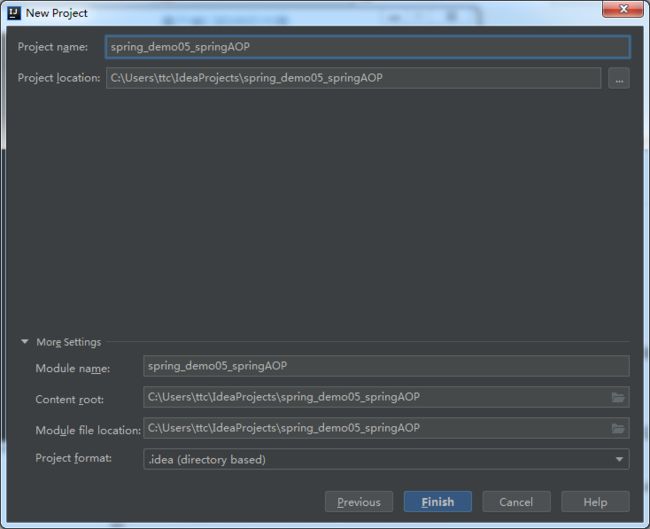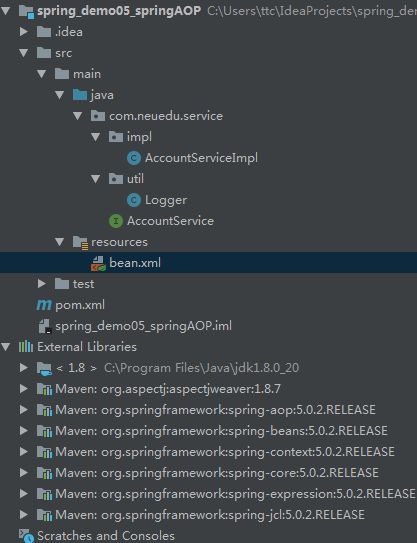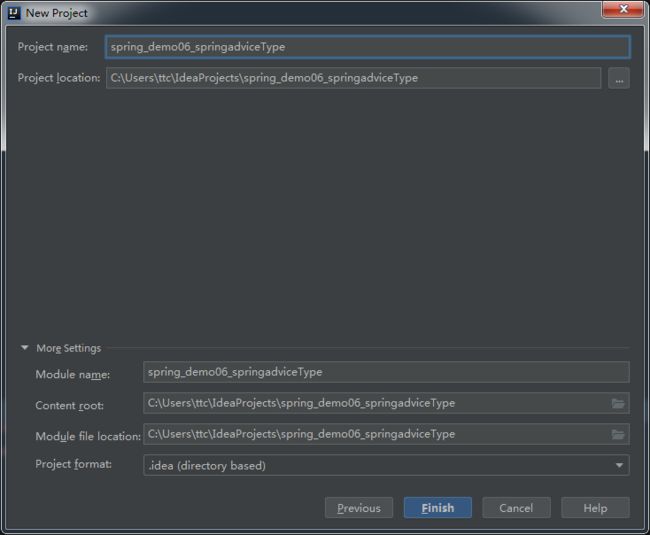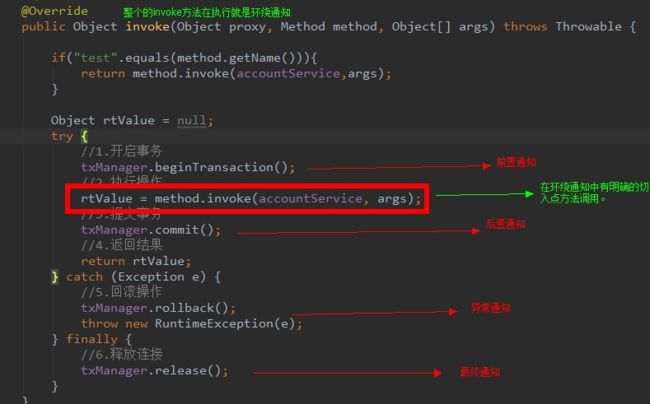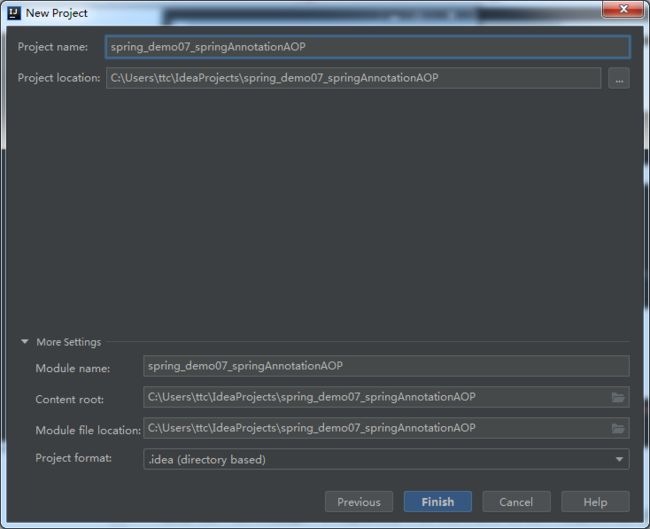1、AOP概述
什么是 AOP
AOP:全称是 Aspect Oriented Programming 即:面向切面编程。
在软件业,AOP为Aspect Oriented Programming的缩写,意为:面向切面编程,通过预编译方式和运行期动态代理实现程序功能的统一维护的一种技术。AOP是OOP的延续,是软件开发中的一个热点,也是Spring框架中的一个重要内容,是函数式编程的一种衍生范型。利用AOP可以对业务逻辑的各个部分进行隔离,从而使得业务逻辑各部分之间的耦合度降低,提高程序的可重用性,同时提高了开发的效率。
简单的说它就是把我们程序重复的代码抽取出来,在需要执行的时候,使用动态代理的技术,在不修改源码的基础上,对我们的已有方法进行增强。
AOP 的作用及优势
作用:
在程序运行期间,不修改源码对已有方法进行增强。
优势:
减少重复代码
提高开发效率
维护方便
AOP的实现方式
使用动态代理技术
动态代理
动态代理的特点:
字节码随用随创建,随用随加载。 它与静态代理的区别也在于此。因为静态代理是字节码一上来就创建好,并完成加载。 装饰者模式就是静态代理的一种体现。
动态代理常用的有两种方式:
基于接口的动态代理
提供者:JDK官方的Proxy类。
要求:被代理类最少实现一个接口。
基于子类的动态代理
提供者:第三方的CGLib,如果报asmxxxx异常,需要导入asm.jar。 要求:被代理类不能用final修饰的类(最终类)。
1、使用JDK官方的Proxy类创建代理对象
一个演员的例子: 在很久以前,演员和剧组都是直接见面联系的。没有中间人环节。 而随着时间的推移,产生了一个新兴职业:经纪人(中间人),这个时候剧组再想找演员就需要通过经纪人来找了。
/**
* 一个经纪公司的要求:
* 能做基本的表演和危险的表演
* */
public interface IActor {
/**
* 基本演出
* @param money
* */
public void basicAct(float money);
/**
* 危险演出
* @param money
* */
public void dangerAct(float money);
}
/**
* 一个演员
* */
// 实现了接口,就表示具有接口中的方法实现。即:符合经纪公司的要求
public class Actor implements IActor {
public void basicAct(float money) {
System.out.println("拿到钱,开始基本的表演:" + money);
}
public void dangerAct(float money) {
System.out.println("拿到钱,开始危险的表演:" + money);
}
}
public class Client {
public static void main(String[] args) {
// 一个剧组找演员:
final Actor actor = new Actor();// 直接
/**
* 代理:
* 间接。
*
* 获取代理对象:
* 要求:
* 被代理类最少实现一个接口
* 创建的方式
* Proxy.newProxyInstance(三个参数)
* 参数含义:
* ClassLoader:和被代理对象使用相同的类加载器。
* Interfaces:和被代理对象具有相同的行为。实现相同的接口。
* InvocationHandler:如何代理。
* 策略模式,使用场景是:数据有了,目的明确。如何达成目标,就是策略。
*
*/
IActor proxyActor = (IActor) Proxy.newProxyInstance(actor.getClass().getClassLoader(),
actor.getClass().getInterfaces(), new InvocationHandler() {
/**
* 执行被代理对象的任何方法,都会经过该方法。
* 此方法有拦截的功能。
* 参数:
* proxy:代理对象的引用。不一定每次都用得到
* method:当前执行的方法对象
* args:执行方法所需的参数
* 返回值:
* 当前执行方法的返回值
*/
@Override
public Object invoke(Object proxy, Method method, Object[] args) throws Throwable {
String name = method.getName();
Float money = (Float) args[0];
Object rtValue = null;
// 每个经纪公司对不同演出收费不一样,此处开始判断
if ("basicAct".equals(name)) {
// 基本演出,没有2000不演
if (money > 2000) {
// 看上去剧组是给了8000,实际到演员手里只有4000
// 这就是我们没有修改原来basicAct方法源码,对方法进行了增强
rtValue = method.invoke(actor, money / 2);
}
}
if ("dangerAct".equals(name)) {
// 危险演出,没有5000不演
if (money > 5000) {
// 看上去剧组是给了50000,实际到演员手里只有25000
// 这就是我们没有修改原来dangerAct方法源码,对方法进行了增强
rtValue = method.invoke(actor, money / 2);
}
}
return rtValue;
}
});
// 没有经纪公司的时候,直接找演员。
// actor.basicAct(1000f);
// actor.dangerAct(5000f);
// 剧组无法直接联系演员,而是由经纪公司找的演员
proxyActor.basicAct(8000f);
proxyActor.dangerAct(50000f);
}
}
2、使用CGLib的Enhancer类创建代理对象
还是那个演员的例子,只不过不让他实现接口。
/**
* 一个演员
*/
public class Actor {
// 没有实现任何接口
public void basicAct(float money) {
System.out.println("拿到钱,开始基本的表演:" + money);
}
public void dangerAct(float money) {
System.out.println("拿到钱,开始危险的表演:" + money);
}
}
public class Client {
/**
* 基于子类的动态代理 要求: 被代理对象不能是最终类 用到的类: Enhancer 用到的方法: create(Class, Callback)
* 方法的参数: Class:被代理对象的字节码 Callback:如何代理
*
* @param args
*/
public static void main(String[] args) {
final Actor actor = new Actor();
Actor cglibActor = (Actor) Enhancer.create(actor.getClass(), new MethodInterceptor() {
/**
* 执行被代理对象的任何方法,都会经过该方法。
* 在此方法内部就可以对被代理对象的任何方法进行增强。
*
* 参数
* 前三个和基于接口的动态代理是一样的。
* MethodProxy:当前执行方法的代理对象。
*
* 返回值:
* 当前执行方法的返回值
*/
@Override
public Object intercept(Object proxy, Method method, Object[] args, MethodProxy methodProxy)
throws Throwable {
String name = method.getName();
Float money = (Float) args[0];
Object rtValue = null;
if ("basicAct".equals(name)) {
// 基本演出
if (money > 2000) {
rtValue = method.invoke(actor, money / 2);
}
}
if ("dangerAct".equals(name)) {
// 危险演出
if (money > 5000) {
rtValue = method.invoke(actor, money / 2);
}
}
return rtValue;
}
});
cglibActor.basicAct(10000);
cglibActor.dangerAct(100000);
}
}
2、Spring中的AOP
Spring中AOP的细节
AOP相关术语
- Joinpoint(连接点): 所谓连接点是指那些被拦截到的点。在spring中,这些点指的是方法,因为spring只支持方法类型的连接点。
- Pointcut(切入点): 所谓切入点是指我们要对哪些Joinpoint进行拦截的定义。
- Advice(通知/增强): 所谓通知是指拦截到Joinpoint之后所要做的事情就是通知。 通知的类型:前置通知,后置通知,异常通知,最终通知,环绕通知。
- Introduction(引介): 引介是一种特殊的通知在不修改类代码的前提下, Introduction可以在运行期为类动态地添加一些方法或Field。
- Target(目标对象): 代理的目标对象。
- Weaving(织入): 是指把增强应用到目标对象来创建新的代理对象的过程。 spring采用动态代理织入,而AspectJ采用编译期织入和类装载期织入。
- Proxy(代理): 一个类被AOP织入增强后,就产生一个结果代理类。
- Aspect(切面): 是切入点和通知(引介)的结合。
学习spring中的AOP要明确的事
开发阶段(我们做的)
1、编写核心业务代码(开发主线):大部分程序员来做,要求熟悉业务需求。
2、将公用代码抽取出来,制作成通知。(开发阶段最后再做):AOP编程人员来做。
3、在配置文件中,声明切入点与通知间的关系,即切面。:AOP编程人员来做。运行阶段(Spring框架完成的)
Spring框架监控切入点方法的执行。一旦监控到切入点方法被运行,使用代理机制,动态创建目标对象的代理对象,根据通知类别,在代理对象的对应位置,将通知对应的功能织入,完成完整的代码逻辑运行。
3、关于代理的选择
在spring中,框架会根据目标类是否实现了接口来决定采用哪种动态代理的方式。
基于XML的AOP配置
前期准备
创建新工程
配置文件pom.xml
4.0.0
com.neuedu
spring_demo05_springAOP
1.0-SNAPSHOT
jar
org.springframework
spring-context
5.0.2.RELEASE
org.aspectj
aspectjweaver
1.8.7
AccountService接口
package com.neuedu.service;
/**
* 账户的业务层接口
* */
public interface AccountService {
/**
* 模拟保存账户
*/
void saveAccount();
/**
* 模拟更新账户
* @param i
*/
void updateAccount(int i);
/**
* 删除账户
* @return
*/
int deleteAccount();
}
AccountService实现类
package com.neuedu.service.impl;
import com.neuedu.service.AccountService;
/**
* 账户的业务层实现类
*/
public class AccountServiceImpl implements AccountService {
@Override
public void saveAccount() {
System.out.println("执行了保存");
}
@Override
public void updateAccount(int i) {
System.out.println("执行了更新"+i);
}
@Override
public int deleteAccount() {
System.out.println("执行了删除");
return 0;
}
}
Logger.java
package com.neuedu.service.util;
/**
* 用于记录日志的工具类,它里面提供了公共的代码
*/
public class Logger {
/**
* 用于打印日志:计划让其在切入点方法执行之前执行(切入点方法就是业务层方法)
*/
public void printLog(){
System.out.println("Logger类中的pringLog方法开始记录日志了。。。");
}
}
bean.xml
spring中基于XML的AOP配置步骤:
1、把通知Bean也交给spring来管理
2、使用aop:config标签表明开始AOP的配置
3、使用aop:aspect标签表明配置切面
id属性:是给切面提供一个唯一标识
ref属性:是指定通知类bean的Id。
4、在aop:aspect标签的内部使用对应标签来配置通知的类型
让printLog方法在切入点方法执行之前执行:所以是前置通知
aop:before:表示配置前置通知
method属性:用于指定Logger类中哪个方法是前置通知
pointcut属性:用于指定切入点表达式,该表达式的含义指的是对业务层中哪些方法增强
切入点表达式的写法:
关键字:execution(表达式)
表达式:访问修饰符 返回值 包名.包名.包名...类名.方法名(参数列表)
标准的表达式写法:
public void com.neuedu.service.impl.AccountServiceImpl.saveAccount()
测试类
package com.neuedu.test;
import com.neuedu.service.IAccountService;
import org.springframework.context.ApplicationContext;
import org.springframework.context.support.ClassPathXmlApplicationContext;
/**
* 测试AOP的配置
*/
public class AOPTest {
public static void main(String[] args) {
//1.获取容器
ApplicationContext ac = new ClassPathXmlApplicationContext("bean.xml");
//2.获取对象
AccountService as = (IAccountService)ac.getBean("accountService");
//3.执行方法
as.saveAccount();
}
}
切入点表达式全通配写法:
* *..*.*(..)
//3.执行方法
as.saveAccount();
as.updateAccount(1);
as.deleteAccount();
全通配表达式演变过程:
1)访问修饰符可以省略
void com.neuedu.service.impl.AccountServiceImpl.saveAccount()
2)返回值可以使用通配符,表示任意返回值
* com.neuedu.service.impl.AccountServiceImpl.saveAccount()
3)包名可以使用通配符,表示任意包。但是有几级包,就需要写几个*.
* *.*.*.*.AccountServiceImpl.saveAccount())
4)包名可以使用..表示当前包及其子包
* *..AccountServiceImpl.saveAccount()
5)类名和方法名都可以使用*来实现通配
`* *..*.*()
6)参数列表:
可以直接写数据类型:
基本类型直接写名称 int
引用类型写包名.类名的方式 java.lang.String
可以使用通配符表示任意类型,但是必须有参数
可以使用..表示有无参数均可,有参数可以是任意类型
* *..*.*(..)
实际开发中切入点表达式的通常写法:
切到业务层实现类下的所有
* com.neuedu.service.impl.*.*(..)
四种常用通知类型
建立新工程(可以以前一个工程为模板)
pom.xml
4.0.0
com.neuedu
spring_demo06_springadviceType
1.0-SNAPSHOT
jar
org.springframework
spring-context
5.0.2.RELEASE
org.aspectj
aspectjweaver
1.8.7
bean.xml
工具类Logger修改
package com.neuedu.service.util;
/**
* 用于记录日志的工具类,它里面提供了公共的代码
*/
public class Logger {
/**
* 前置通知
*/
public void beforePrintLog(){
System.out.println("前置通知Logger类中的beforePrintLog方法开始记录日志了。。。");
}
/**
* 后置通知
*/
public void afterReturningPrintLog(){
System.out.println("后置通知Logger类中的afterReturningPrintLog方法开始记录日志了。。。");
}
/**
* 异常通知
*/
public void afterThrowingPrintLog(){
System.out.println("异常通知Logger类中的afterThrowingPrintLog方法开始记录日志了。。。");
}
/**
* 最终通知
*/
public void afterPrintLog(){
System.out.println("最终通知Logger类中的afterPrintLog方法开始记录日志了。。。");
}
}
bean.xml
切入点表达式
配置切入点表达式 aop:pointcut
id属性:用于指定表达式的唯一标识。
expression属性:用于指定表达式内容
注意:此标签写在aop:aspect标签内部只能当前切面使用。还可以写在aop:aspect外面,此时就变成了所有切面可用
环绕通知
/**
* 环绕通知
* */
public void aroundPringLog(){
System.out.println("Logger类中的aroundPringLog方法开始记录日志了。。。");
}
业务没有打印,但是通知缺打印了
出现问题:当我们配置了环绕通知之后,切入点方法没有执行,而通知方法执行了。
分析:通过对比动态代理中的环绕通知代码,发现动态代理的环绕通知有明确的切入点方法调用,而我们的代码中没有。
解决:
Spring框架为我们提供了一个接口:ProceedingJoinPoint。该接口有一个方法proceed(),此方法就相当于明确调用切入点方法。该接口可以作为环绕通知的方法参数,在程序执行时,spring框架会为我们提供该接口的实现类供我们使用。
/**
* 环绕通知
* */
public Object aroundPringLog(ProceedingJoinPoint pjp){
Object rtValue = null;
try {
Object[] args = pjp.getArgs();//得到方法执行所需的参数
System.out.println("Logger类中的aroundPringLog方法开始记录日志了。。。前置");
pjp.proceed(args);//明确调用业务层方法(切入点方法)
System.out.println("Logger类中的aroundPringLog方法开始记录日志了。。。后置");
return rtValue;
} catch (Throwable t) {//不能写Exception,因为拦截不住
System.out.println("Logger类中的aroundPringLog方法开始记录日志了。。。异常");
throw new RuntimeException(t);
}finally {
System.out.println("Logger类中的aroundPringLog方法开始记录日志了。。。最终");
}
}
注意:环绕通知是spring框架为我们提供的一种可以在代码中手动控制增强方法何时执行的方式。
基于注解的AOP配置
利用之前的工程
修改
/**
* 账户的业务层实现类
*/
@Service("accountService")
public class AccountServiceImpl implements AccountService {...}
package com.neuedu.service.util;
import org.aspectj.lang.ProceedingJoinPoint;
import org.aspectj.lang.annotation.*;
import org.springframework.stereotype.Component;
/**
* 用于记录日志的工具类,它里面提供了公共的代码
*/
@Component("Logger")
@Aspect//表示当前类是一个切面类
public class Logger {
//切入点表达式
@Pointcut("execution(* com.neuedu.service.impl.*.*(..))")
private void pt1(){}
/**
* 前置通知
*/
@Before("pt1()")
public void beforePrintLog(){
System.out.println("前置通知Logger类中的beforePrintLog方法开始记录日志了。。。");
}
/**
* 后置通知
*/
@AfterReturning("pt1()")
public void afterReturningPrintLog(){
System.out.println("后置通知Logger类中的afterReturningPrintLog方法开始记录日志了。。。");
}
/**
* 异常通知
*/
@AfterThrowing("pt1()")
public void afterThrowingPrintLog(){
System.out.println("异常通知Logger类中的afterThrowingPrintLog方法开始记录日志了。。。");
}
/**
* 最终通知
*/
@After("pt1()")
public void afterPrintLog(){
System.out.println("最终通知Logger类中的afterPrintLog方法开始记录日志了。。。");
}
/**
* 环绕通知
* */
//@Around("pt1()")
public Object aroundPringLog(ProceedingJoinPoint pjp){
Object rtValue = null;
try {
Object[] args = pjp.getArgs();//得到方法执行所需的参数
System.out.println("Logger类中的aroundPringLog方法开始记录日志了。。。前置");
pjp.proceed(args);//明确调用业务层方法(切入点方法)
System.out.println("Logger类中的aroundPringLog方法开始记录日志了。。。后置");
return rtValue;
} catch (Throwable t) {//不能写Exception,因为拦截不住
System.out.println("Logger类中的aroundPringLog方法开始记录日志了。。。异常");
throw new RuntimeException(t);
}finally {
System.out.println("Logger类中的aroundPringLog方法开始记录日志了。。。最终");
}
}
}
bean.xml
spring的注解的通知执行有问题
注释4种通知,开启环绕,因为通常情况下,环绕通知都是独立使用的
注意:如果使用注解,建议使用环绕通知
不使用XML的配置方式
@Configuration
作用: 用于指定当前类是一个spring配置类,当创建容器时会从该类上加载注解。获取容器时需要使用AnnotationApplicationContext(有@Configuration注解的类.class)。
属性: value:用于指定配置类的字节码
@Configuration
public class SpringConfiguration { }
@ComponentScan
作用: 用于指定spring在初始化容器时要扫描的包。作用和在spring的xml配置文件中的:
属性: basePackages:用于指定要扫描的包。和该注解中的value属性作用一样。
/**
*spring的配置类,相当于bean.xml文件
*/
@Configuration
@ComponentScan("com.neuedu")
public class SpringConfiguration { }
新建一个类
package config;
import org.springframework.context.annotation.ComponentScan;
import org.springframework.context.annotation.Configuration;
/**
* 该类是一个配置类,它的作用和bean.xml是一样的
* spring中的新注解
* Configuration
* 作用:指定当前类是一个配置类
* 细节:当配置类作为AnnotationConfigApplicationContext对象创建的参数时,该注解可以不写。
*
* ComponentScan
* 作用:用于通过注解指定spring在创建容器时要扫描的包
* 属性:
* value:它和basePackages的作用是一样的,都是用于指定创建容器时要扫描的包。
* 我们使用此注解就等同于在xml中配置了:
* @Component("Logger")
@EnableAspectJAutoProxy
@Aspect//表示当前类是一个切面类
public class Logger {...}
测试类:
package com.neuedu.test;
import com.neuedu.service.AccountService;
import config.SpringConfiguration;
import org.springframework.context.ApplicationContext;
import org.springframework.context.annotation.AnnotationConfigApplicationContext;
import org.springframework.context.support.ClassPathXmlApplicationContext;
public class AOPTest {
public static void main(String[] args) {
//1.获取容器
ApplicationContext ac = new AnnotationConfigApplicationContext(SpringConfiguration.class);
//2.获取对象
AccountService as = (AccountService)ac.getBean("accountService");
//3.执行方法
as.saveAccount();
}
}

